Assaut d'Armes. . .
The full title of this extremely rare print is: Assaut d'Armes donné a Calton House, le 9 Avril 1787 entre La Chevaliere d'Eon de Beaumont et Le Chevalier de Saint George en la presence de Son Altesse le Prince de Wales, la Noblesse & plusieurs Celebres, Maitres d'Armes. Gillray's name is listed as the sole designer (Gillray inv.), but there is neither date nor publisher included.
A second state or version of the print provides what is, in effect, a translation of the French title. The Assaut, or Fencing Match, which took place at Carlton House on the 9th of April, 1787, between Mademoiselle La Chevaliere d'Eon de Beaumont and Monsieur de Saint George. In the presence of His Royal Highness the Prince of Wales, several of the Nobility, & many eminent Fencing Masters of London. It adds a Latin quotation from Vergil and an oddly non-specific publication line—"Published by Conbeau at Paris and by Robindé at London." No addresses for the publishers are listed and once again no date. But what is perhaps most puzzling is that I can find no evidence that either of the supposed publishers existed. Why? What was Gillray up to?
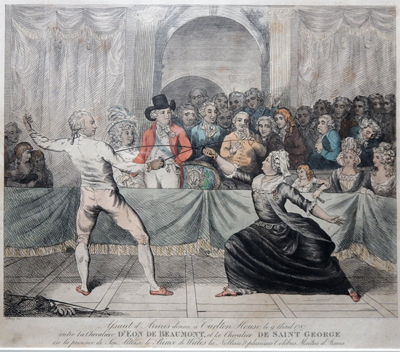
© Malcolm Fare, National Fencing Museum, UK
The two combatants in the print, Le Chevalier de Saint George (1745-1799) on the left and La Chevaliere d'Eon de Beaumont (1728-1810) on the right, were celebrities for more than just their skill in fencing. Saint George was born in the French colony of Guadeloupe to George Bologne de Saint-Georges, a French plantation owner, and Nanon, his wife's African slave. At the age of seven he was taken by his father to France and educated there. By the age of seventeen he had distinguished himself for his consummate skill in fencing, out-dueling masters throughout France. But by 1772 he had also debuted as a violin solist playing his own violin concertos. And by 1787 when this duel took place, he was the composer of numerous symphonies, string quartets, sonatas, concertos, and operas.
La Chevaliere d'Eon de Beaumont had a varied career as a political writer, secretary to the intendant of Paris, a spy for the King Louis XV, the Chargé d'affaires to England, and a blackmailer. But she was most notorious for the uncertainty of her sexuality.* She spent the first half of her life as a man, and the second, as a woman. As a man she had often worn the uniform of a dragoon, and perhaps it was in training for military service that she became an accomplished fencer. By 1787, she was in exile from France, now living in London as a woman when the opportunity presented itself to fight the famous fencer/composer Le Chevalier de Saint George.
The match was most likely initiated by Henry Angelo (1756-1835), the son of Domenico Angelo (1717-1802) the founder of the renowned Angelo School of Arms which included among its former students, King George III, and his brothers, the Dukes of York, Gloucester, and Cumberland. When the two younger Princes suggested that an illustrated treatise on fencing would be helpful, Domenico wrote and had published the now famous treatise of fencing, the L'Ecole des Armes (School of Fencing) (1763) using himself as the model for its numerous illustrations. The treatise was dedicated to the two Princes. In 1771, Domenico further solidified his reputation by being named as fencing master for the first two sons of George III, George and Frederick, both of whom appear in Gillray's portrayal of the event. By 1780, however, Domenico had retired from the day to day operations of the business and his son Henry Angelo had now taken over. Like his father he was adept at cultivating the reputation of fencing as a sport of gentlemen, and his school as the preeminent academy for the sport. It is almost certainly no accident that this match of two controversial figures would have been arranged to coincide with the republication of his father's treatise on fencing in 1787.
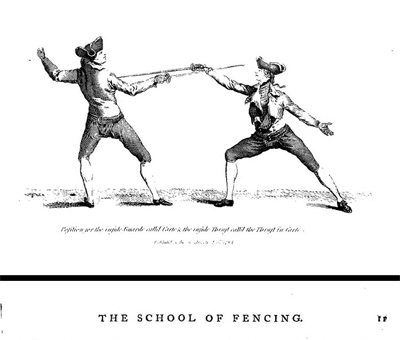
© Internet Archive
Gillray portrays the moment that Mademoiselle D'Eon scores a hit, showing excellent form. Watching the match are the Prince of Wales with Mrs. Fitzherbert standing to the side of the Royal chair with the insignia of the Prince of Wales. Just behind him is the Prince's friend, the bushy-browed Charles James Fox. Just behind the Prince's chair is his younger brother, the Duke of York, identified by the barely visible star on his chest. Both had been students of Domenico Angelo at his fencing academy. The portly man who appears to be falling asleep is likely Frederick, Lord North, who had a reputation for indolence which Gillray consistently portrayed as narcolepsy. The women in the front row on the right are probably the Duchess of Devonshire and her sister Lady Bessborough with one of her children. Both ladies travelled in the same gambling circles as the Prince of Wales and were ardent suppporters of the Whig leader, Charles James Fox. Taking Gillray at his word that "many eminent Fencing Masters of London" were in attendance, we can guess that the older man looking through a glass is intended to be Domenico Angelo (who would have been seventy at the time of the print) and the young man at his side might be his son, Henry.
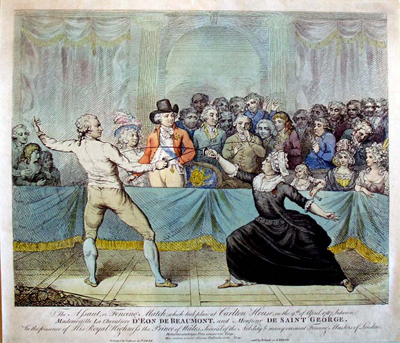
© Princeton University
The English Chronicle or Universal Evening Post for April 10 described the match:
The most remarkable occurrence of the fencing match at Carleton-house, was the assault between Messr De St. George and Mademoiselle D'Eon; the latter, though incumbered, as she humorously declared it herself, with three petticoats, that suited her sex much better than her spirit, not only parried skilfully all the thrusts of her powerful antagonist, but even touched him by what is termed a Coup de Temps, which all his dexterity could not ward off. We hear that a celebrated painter has undertaken to hit off the semblance or attitude of the hero and heroine, in this very interesting scene. Mademoiselle D'Eon had modesty enough, on her hitting M. De St. George, to set it down to his complaisance; but the latter candidly declared, that the thrust was the fairer, that he had done all in his power to ward against it. A gentleman present assures us, that nothing could equal the quickness of the repartee especially considering that the modern Pallas is nearly in her 60th year, and had to cope with a young man equally skillful and vigorous.
The account in the English Chronicle is consistent with Gillray's portrayal, but adds a significant detail, that "a celebrated painter has undertaken to hit off the semblance or attitude of the hero and heroine, in this very interesting scene." That painter was another multi-talented friend of the Prince of Wales, Abbé Alexandre-Auguste Robineau (1747-1828).
Robineau was a Catholic priest, a brilliant violinist, a composer, as well as a painter. According to the Royal Collection Trust, "He was in London a great deal in the 1780s coming into contact with the Prince of Wales in both his professional capacities." As a painter, however, he seems to have created mostly single figure compositions. And if the portraits of the Prince of Wales and the Chevalier de Saint-George in the Royal Collection are any indication, he was certainly no threat to any of the English portraitists like Reynolds, Romney, Gainsborough, or Hoppner. The left arm of Saint George is very awkward and unlike the faces in Gillray's print which include a number of identifiable members of the Prince's entourage, the faces of Robineau's painting are blank and characterless.
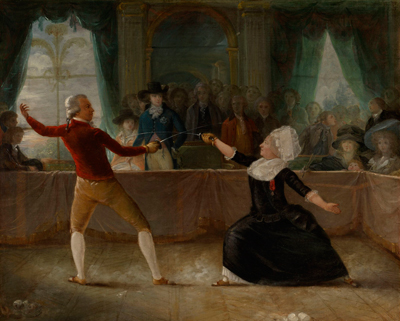
The Fencing-Match
between the Chevalier de Saint-George and the Chevalier d'Eon
[1787]
© Royal Collection Trust
Before we identify any further differences between Gillray's print an the painting by Robineau, however, we need to look at an article in the London World Fashionable Advertiser for 24 November 1787 which may help to provide an explanation of why Gillray's clearly superior version received so little circulation.
For Publishing by SUBSCRIPTION
A PRINT, representing the Assaut, or Fencing Match, which took place at Carlton House, on the 9th of April, 1787 between Mademoiselle La Chevaliere D'EON de BEAUMONT, and Monsieur Le Chevalier *St GEORGE. Dedicated, by Permission, to His Royal Highness-the PRINCE of WALES. . . .
It is from Mr. Robineau's Picture, now in the possession of His Royal Highness the Prince of Wales, and greatly admired for the striking Likeness, with the persons then present that the above Print is to be taken in Chalk-manner. The engraving will be executed by Mr. Saillard, already advantageously known by the Masterly Print of the Prince's small whole length Piclure by Cosway.
Among the principal Personages represented in the Picture and amidst a concourse of fifty spectators, the most conspicuous figure, and certainly, to every eye, the most pleasing is that of the Prince of Wales; and beneath, those of the Chevalier St. George and Mademoiselle D'Eon in their fencing attitudes. . . .
Subscriptions at One Guinea each, are received by Mess. Ransom, Morland, and Hammersley, Bankers, No, 57, Pall-Mall, who will deliver Mr. Robineau's Receipt.
What this tells us is that Robineau finished the painting some time before 24 November 1787 and by then had already made arrangements for a print to be engraved by Louis Saillar, and dedicated to the Prince. As fate would have it, however, Saillar was ultimately replaced by another Frenchman, the engraver Victor Marie Picot, a member of the Royal Academy, and the shifting between engravers may account for the fact that the print based upon the painting did not appear until 20 June 1789, more than 2 years after the original event.
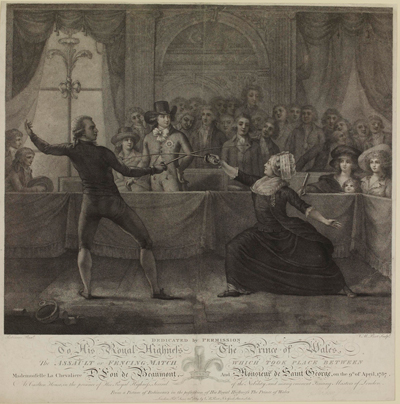
Based on the Robineau painting.
[June 20, 1789]
© Trustees of the British Museum
Given this (admittedly complicated) history, the common, but usually unexamined assumption that Gillray worked from the Robineau painting or the Picot print runs into some significant obstacles. If he worked from the Robineau painting, for instance, how would that have come about? If Robineau already had a plan to have his painting engraved by someone else, why would he have made it available to Gillray? And why if a prince-approved competitor was already assigned the task, would Gillray have wasted his time creating a competing version. Assuming that Gillray worked from the Picot print makes even less sense. The success of Gillray's work in 1787 depended upon its topicality. It had to reflect the public's current interests. When Picot's print was finally available in 1789, the fencing match was very old news indeed. Gillray would have had no incentive to begin a print at that point.
But suppose Gillray's print was the starting point for Robineau, not vice versa, and in fact suppose Gillray was commisioned to create the print for Robineau's benefit, the sequence of events begins to make a lot more sense. As I mentioned earlier, Robineau was much more of a musician than an artist; his artistic work seems to have consisted of mostly single figure portraits and even those were mediocre. He may have been intimidated by the prospect of portraying a duel in action with a roomful of notable spectators and either requested or been advised to get help. Gillray had already demonstrated his ability to produce complex multi-figure prints such as A New Way to Pay the National Debt (21 April 1786), A Sale of English Beauties in the East-Indies (16 May 1786), and the notorious Wife & No Wife, or a Trip to the Continent (27 March, 1786) which already contained portraits of four of the figures included in Assaut. Using available images of the combatants, Angelo's illustrated L'Ecole des Armes, and his own knowledge of other notable attendees, Gillray could even have created the print without attending the event in person.
If I am correct that someone commissioned Gillray's print to assist Robineau, the French version of Assaut d'Armes would have had no need for a publication line since it had an intended audience of one—Robineau. That would help explain the all-French text, and the effort Gillray obviously invested in it. He may have hoped that Robineau's aristocratic connections would lead to further commisions. It would also explain why Gillray's version includes Mrs. Fitzherbert. He was working from the actual guest list, not from the Robineau print where her presence had been edited out. It would explain why he didn't seek an immediate publisher for the print. He had done his job and already been paid. And finally, it would explain the extreme rarity of the print. The print in the National Fencing Museum is, in effect, a final proof, a copy for Gillray's own records.
What about the English version? Gillray couldn't in good conscience publish any version of his work without Robineau's (and the Prince's) permission. But as the official version floated between Saillar and Picot and its completion date continued to be delayed, Gillray may have prepared for the possibility of eventual permission and publication by creating a new English title with a dummy publication line. And as he sometimes did, he gave the publishers fabricated names as placeholders—Conbeau suggesting beauty; Robinde suggesting the association with Robineau.
That's likely where it ended during Gillray's lifetime. But when Henry G. Bohn obtained the Gillray plates, he found and published the English version of the print with its fictional publication line as part of his 1851 edition of Gillray's Works. But if I am correct that the publishers are indeed fictional, that would suggest that the only source for the publication of any English versions extant in museums and collections is the Bohn edition.
* I refer to her as "she" throughout this commentary because at this time she presented herself as a woman. An autopsy at her death was somewhat ambiguous. She had the genitals of a male, but the post-mortem certificate also described an "unusual roundness in the formation of the limbs" and a "breast remarkably full."
Sources and Reading
- "History of fencing," Wikipedia
- Fencing's Royal Connection
- "Chevalier de Saint-Georges," Wikipedia
- "Chevalier d'Éon," Wikipedia
- The School of Fencing 1787
- "Abbé Alexandre-Auguste Robineau," Wikipedia
- Thomas Wright and R.H. Evans, Historical and Descriptive Account of the Caricatures of James Gillray #375
- Thomas Wright and Joseph Grego, The Works of James Gillray, the Caricaturist; With the History of His Life and Times p. 87.
Comments & Corrections
NOTE: Comments and/or corrections are always appreciated. To make that easier, I have included a form below that you can use. I promise never to share any of the info provided without your express permission.